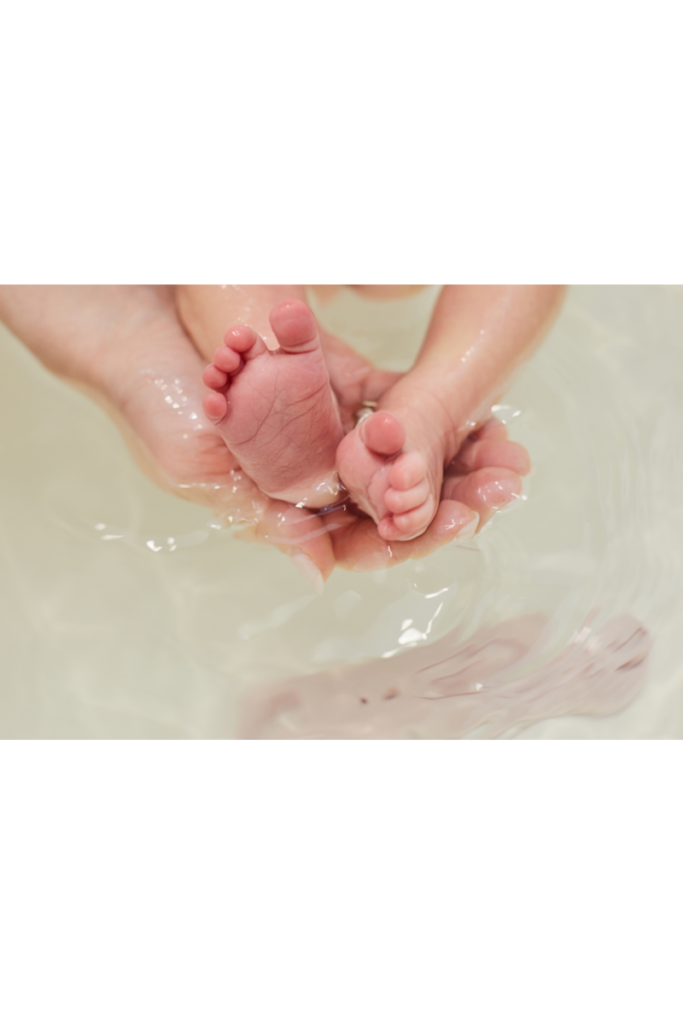5 easy ways to build your child’s language skills during bath time
“Just add water”. The saying goes for more than just pancake mix!
Baths are a great way to calm down littles when they are having an especially hard time, are incredibly bored, or need a good scrubbing.
But did you know that bath time activities are also a great opportunity to build your child’s language skills?
Encouraging learning through play and everyday routines is one of the best ways to help your child grow and learn. Learning happens best in natural environments and activities, and bath time is one of those routines and activities that most children love!
Let’s dive into 5 easy ways you can help build your child’s language skills during bath time!

1) Identify Body Parts
Teaching body parts while bathing is such a functional and easy way to build those vocabulary skills! Tell your child each body part as you are washing it and let them wash it themselves. You can even incorporate a “my turn/your turn”.
Helping to teach children how to wash themselves early on will help them to develop self-help skills and boost their confidence.
If you want a fun spin on this, try this song: (sing to the beat of “This is the way we___”)
*This is the way we wash our feet, wash our feet, wash our feet, this is the way we wash our feet when we take a bath” Repeat for each body part.
Fun Fact: Language is housed in the left side of the brain while music/melody is housed in the right side. When you add melody to language it gets both sides of the brain working together which is why you can remember lyrics to songs so well but unfortunately forget what’s on the grocery list the moment you leave the house. Whenever you want to remember something or to teach something important, add a melody to it!
Bath-time is full of opportunities to teach concepts and their opposites! Here’s a few examples: on/off (water); full/empty (tub or cups); wet/dry (body). Simply taking the time to talk to your child about these concepts during bath-time is not only helping build their vocabulary but it’s building functional understanding too!
2) Opposites
Bath time is such an amazing opportunity to teach opposites. Opposites are words that have very different meanings from each other (i.e. hot/cold, up/down).
There are literally SO many great ways to naturally incorporate these important littles words into your bath time routine. You might be thinking “uh that’s a little awkward and boring”. But hear me out!
Children learn best through natural and everyday activities. While we may think of a concept like teaching opposites that needs to be done with boring worksheets in a classroom, that thought could not be farther from the truth. Take advantage of your everyday routines to teach these concepts and I promise you will not regret it.
Here’s some examples of how to incorporate quick vocabulary learning with these concepts and their opposites:
* The tub is empty let’s turn the water on to fill it up”..
* The tub is full time to turn the water off.”
*The water is cold let’s make it warm.” —also caution against hot water.
“Bath is all done. You’re wet let’s get a towel to dry off”.
Teaching concepts is as simple as that! Talk about them during real-life and everyday activities and they become more concrete and understandable to your little one.
3) Sink or Float
This one is my FAVORITE!
The name of the game is “Does it sink or does it float?”
Grab several toys or objects from around the house that are water and child safe. As you are collecting your objects name each one and talk about what it is made out of (it’s composition). It is important to have a quick conversation about what materials CAN go into the bathtub and which ones CANNOT.
Our general rule of thumb in our home is only things that are plastic can go into the tub (and nothing with batteries please). Anything that is made out of fabric, metal, or wood needs to stay out. This has actually created great conversations about what different objects are made out of and what happens if they get wet.
Once you have your items, take turns predicting whether the toy or object will sink or float in the water. This helps children develop the concept of having a hypothesis. Next, drop the object or toy into the water and find out whether it sinks or floats! Do you notice anything similar about all the objects that sink and/or float? Why do some sink and some float? This fun game works on prediction skills, vocabulary, comparing and contrasting, and concepts.
To vary this activity try focusing on one category of items (vehicles, animals, blocks, cooking utensils) . My boys love their toy animals so we often talk about which animals live in the water, which ones are land animals, and which ones can do both. It ignites some great thinking and conversations!

4) Pom Craft Balls
Aa a parent you will either love or hate pom craft balls. I have not seen much in between. BUT, these soft and colorful balls are a great addition to make bath time extra fun! The super soft texture and light weight makes some of them float on the water and it is mesmerizing to watch!
Depending on your bathtub and type of drain that you have, and also your child, I would use the medium or larger sized balls to ensure they will not slip down the drain, however, if that is not a concern then feel free to add in a variety of sizes. Incorporating a variety of sizes will help this activity go farther but it is not a necessity.
As the tub is filling with water, let your child pour the pom craft balls into the water. Watch the magic and giggles happen!
This activity in and of itself is a great sensory and open-ended play activity so if your child spends the whole bathtime just playing then that is completely fine. In fact, I recommend to let them have plenty of bathtime opportunities to just play.
If you are wanting to turn this activity into more of a learning activity then use the pom balls to practice identifying colors and naming the colors and counting. Try a fun game of “Find the color”. Name a color and have your little one find as many pom balls of that color that they can.
Which color has the most? Have your child collect all the pom balls of a specific color. Then count them together. Which color has the most? Which color has the least? Do any colors have the same amount?
Look at all the math and vocabulary concepts you have just taught during bath time play!
When you are ready to clean up, use a colander or slotted spoon to scoop the pom balls out of the water. I recommend collecting them on a towel so you can squeeze out excess water. You can then either toss them into a pillowcase and tie the end and dry them in the dryer or lay them flat on a towel to air dry.
Place them into a container or bag and save them for the next fun activity!
5) Sequencing
First-Then-Next-Last. Does that phrase ring a bell?
Although it sounds boring, teaching the sequence of events is a very important developmental skill.
Sequencing is used SO much in our everyday lives and often times we develop this skill without even realizing it. Utilizing bath time is just one more opportunity to help your child develop and expand on their ability to understand the concepts of sequence.
The first way is to naturally teach the sequence of events that occur during bathing. It might differ from person to person but generally it goes something like this: First turn on the water/ fill up the tub, then get in the tub, next wash your body and play, lastly get out and dry off.
Using the sequential words and talking to your child through the bath time process will help them gain an understanding of sequential words such as “first, then, next, last”. Having an understanding of these words and their meaning help children understand how processes all have some kind of sequence to them.
Learning the sequence of bath time will also be a tremendous help later when your child is learning how to bathe themselves. By ensuring they have learned the right processes, you are also setting yourself up for success down the road in teaching them the important life skill of how to bathe themselves and what steps to follow.
If you are like me and have a child who goes through a period where they absolutely despise bath time and it takes every ounce of energy to help them through it, then these words can be of great help. When children know and understand the steps in a process, they can be better prepared for it… even if it is something they do not want to to.
Take the time before the bath starts to explain the process even if it just the simple sentence I mentioned above. Then repeat each step as you are going through it during bath time. Try to keep the wording simple and consistent during each bath time and before long your child will not only know the process but will also have the vocabulary words to go along with it!

Using bath time to help build your child’s language skills is a great way to use a natural everyday routine to help them learn and grow and to spend some fun quality time together!
Happy splashing!
Alycia
